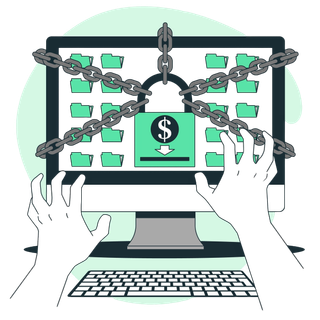Ransomware is a type of malicious software that encrypts files or locks devices, demanding a ransom for their decryption. It is a form of complex malware designed to take control of data, rendering it unusable unless a ransom is paid. A common technique used in ransomware attacks is cryptoviral extortion, where files are encrypted, making them inaccessible, and a ransom is demanded for their decryption. Modern ransomware families focus on encrypting specific file types on infected systems, restricting access and pushing victims to pay the ransom in exchange for decryption keys.
Any internet-connected device is at risk of a ransomware attack. Unlike traditional viruses, ransomware does not self-replicate, which is a key distinction from other types of malware. However, the impact of a ransomware infection can be just as devastating, if not more so, as it can lead to significant financial and data losses.

Common Ransomware Types
Ransomware attacks come in various forms, each with its unique method of operation. One of the most prevalent types is encrypting ransomware, which targets files such as .doc, .xls, and .pdf for encryption. This type of ransomware renders files unusable unless the victim pays for the decryption key, often causing widespread disruption and financial loss.
Another type is non-encrypting ransomware, such as WinLock, which restricts system access without encrypting files, demanding payment to unlock the system.
Ransomware-as-a-Service (RaaS) is another significant threat, where cyber criminals lease ransomware tools to other attackers, broadening the scope of potential ransomware operations. This service model has made ransomware more accessible to a wider range of cyber criminals, increasing the frequency and sophistication of ransomware attacks.
Stages of a Ransomware Attack
Ransomware attacks typically progress through a series of defined stages.
1. Initial Infection
The initial infection phase is critical to understand as it sets the stage for the subsequent ransomware operation. Ransomware commonly spreads via malicious attachments in spam campaigns. Attackers may also use compromised websites, employing tactics such as watering hole attacks, to distribute ransomware.
During this phase, attackers gain access to the network by establishing control and planting malicious encryption software.
2. Encryption Process
Once the ransomware has infiltrated the system, it begins the encryption process. Ransomware like CryptoLocker employs advanced encryption techniques, such as using an AES key to encrypt files, which is then encrypted with an RSA public key. This process locks users out of their files, making recovery without a decryption key impossible.
The encryption process can affect various file types, rendering critical data inaccessible. This phase is particularly damaging as it disrupts the normal operation of the infected system, and without the decryption key, data recovery can be incredibly challenging.
3. Ransom Demand
After encrypting the files, the ransomware displays a full-screen image or notification with payment instructions. This message typically contains details about the status of the encrypted files and the ransom amount that needs to be paid. The on-screen notification explains the ransom amount and the payment process, highlighting the urgency for the victim.
Ransom amounts can fluctuate based on the variant of ransomware and cryptocurrency market rates. Some ransomware variants demand payment specifically in cryptocurrency, such as Bitcoin, to ensure anonymity and minimize traceability. If the ransom is not paid within a specific period, the attackers may increase the ransom amount as a pressure tactic.
These psychological tactics are aimed at convincing victims to comply with payment demands.

How Ransomware Spreads
Ransomware typically spreads through several common methods, each exploiting different vulnerabilities. One of the primary methods is through phishing emails, where cyber criminals send emails containing malicious attachments or links. These emails often appear legitimate, luring unsuspecting users into downloading the malicious software.
Visiting malicious websites is another common way ransomware infections occur. These websites may host exploit kits that automatically download ransomware onto a system when visited. Additionally, spammed email attachments and exploit kits are frequently used to spread ransomware.
Drive-by downloads are another tactic used by ransomware attackers. In this method, merely visiting an infected website can result in ransomware being downloaded onto your system without any further action on your part.
Impact of Ransomware Attacks
Ransomware attacks can have devastating impacts on both individuals and organizations. Financial losses are often substantial, with businesses and individuals paying significant amounts to regain access to their data. The operational disruptions caused by ransomware can lead to lost productivity and revenue, further compounding the financial impact.
The severity of the impact often depends on the response and recovery efforts of the affected organization. Quick and effective response measures can mitigate the damage, while delayed actions can exacerbate the situation. The long-term consequences of a ransomware attack can include reputational damage, loss of customer trust, and potential legal repercussions.
In addition to financial and operational impacts, ransomware attacks can also lead to data breaches, where sensitive information is exposed or stolen. This can have severe implications for privacy and security, especially in sectors like healthcare and finance. The wide-ranging impacts of ransomware attacks underscore the importance of implementing robust cybersecurity measures to prevent and respond to such threats effectively.
